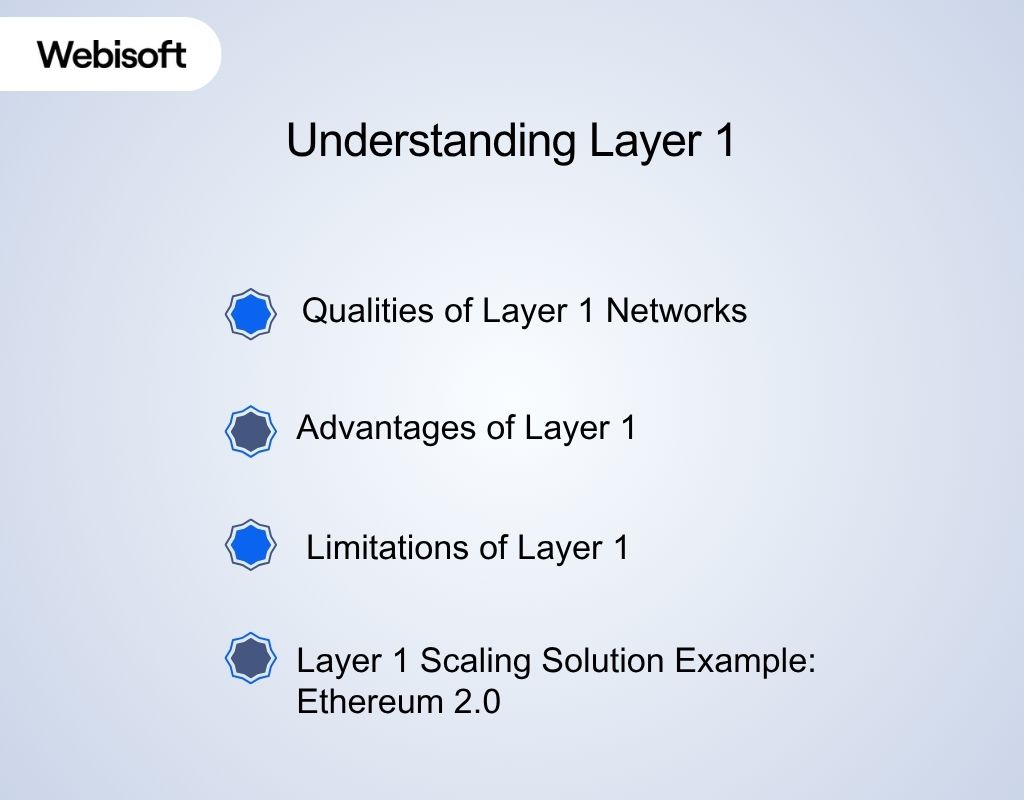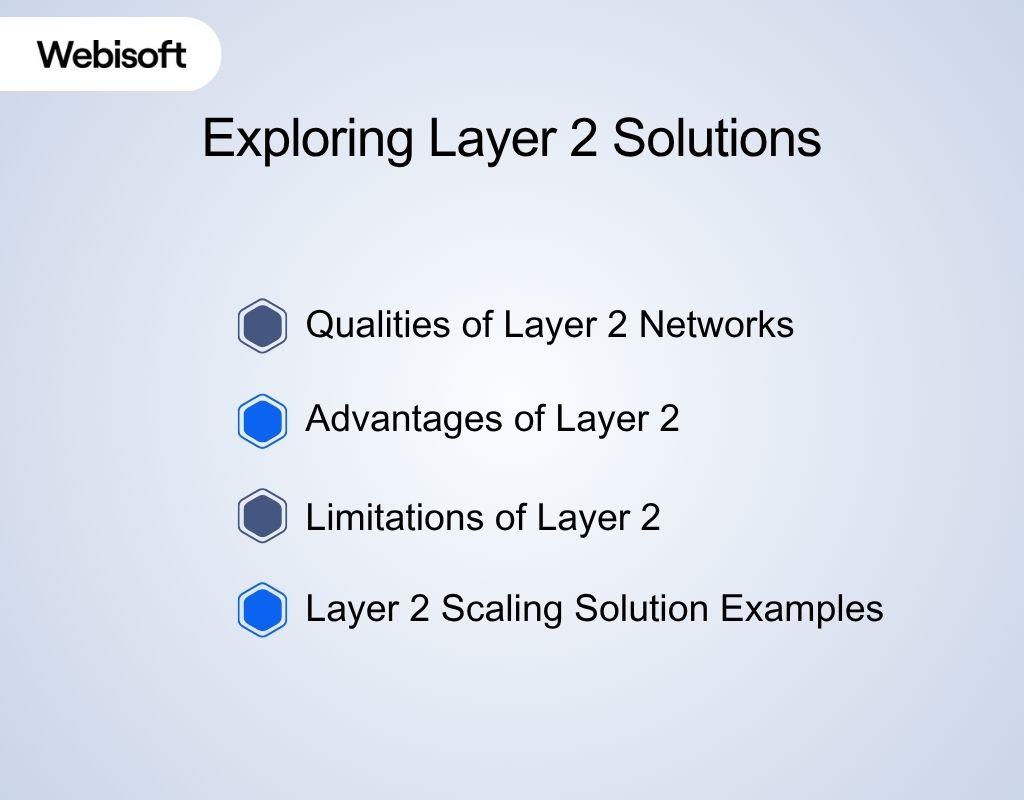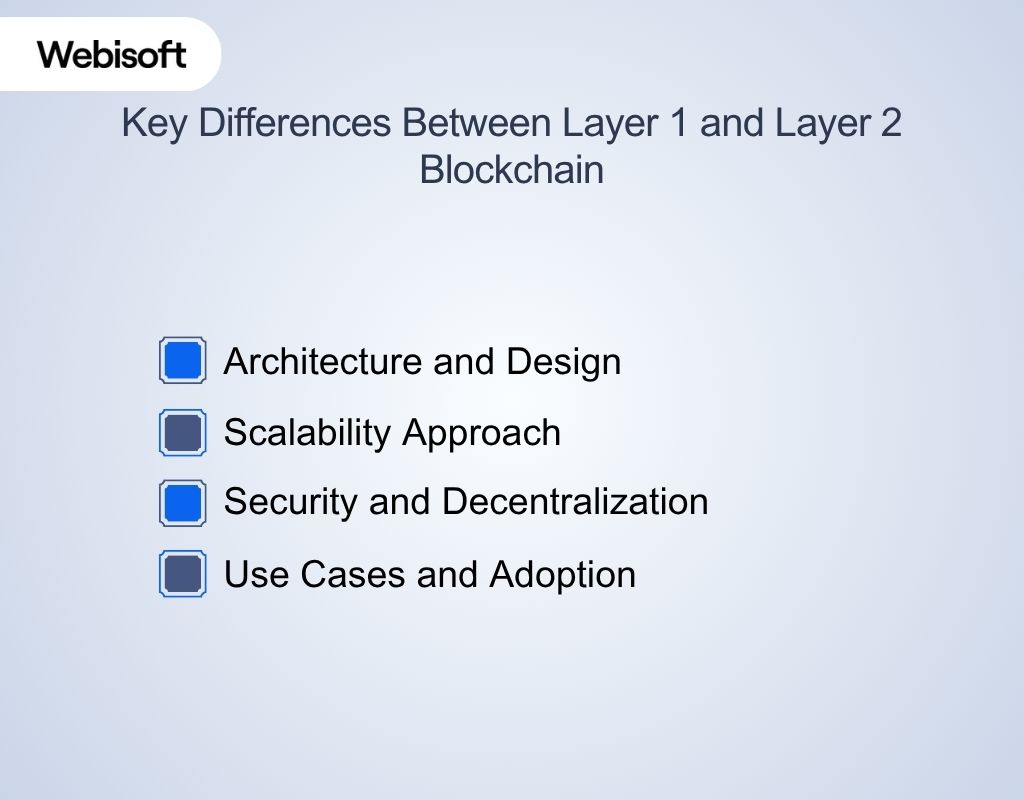Difference Between Layer 1 and Layer 2 Blockchain
- BLOG
- Blockchain
- October 18, 2025
If you want to understand blockchain, it’s important to know the difference between layer 1 and layer 2 blockchain.
Layer 1 is the main blockchain, like Bitcoin or Ethereum, where all transactions are recorded. It’s very secure but can be slow and costly. Layer 2 is built on top of Layer 1 to make transactions faster and cheaper by handling them off the main chain.
In this blog, we will explain the main differences between layer 1 and layer 2 blockchain and why both are needed for better blockchain systems.
Contents
Understanding Layer 1

Layer 1 refers to the base blockchain network itself, the foundational protocol where all transactions, data, and smart contracts are processed and recorded.
Examples of layer 1 crypto blockchains include Bitcoin, Ethereum, Solana, Cardano, and Polkadot.
In simple terms, Layer 1 is the main blockchain that secures the network through its consensus mechanism and maintains the ledger of all activities.
Qualities of Layer 1 Networks:
- Native Consensus Mechanism: Layer 1 blockchains use consensus algorithms like Proof of Work (PoW) or Proof of Stake (PoS) to validate and agree on transactions.
- Decentralization: Many Layer 1 networks emphasize decentralization, meaning no single authority controls the network.
- Security: Layer 1 networks provide strong security guarantees through cryptography and consensus protocols.
- Finality: Transactions on Layer 1 are final and irreversible once confirmed.
- Smart Contract Capability: Many Layer 1 blockchains (like Ethereum) allow developers to deploy and execute smart contracts directly on the base layer.
- Native Token/Currency: Layer 1 blockchains usually have a native token (e.g., ETH for Ethereum, BTC for Bitcoin) used to pay fees and incentivize participants.
Advantages of Layer 1
- Security and Trust: Since Layer 1 is the base protocol, it offers the highest level of security and trust.
- Decentralization: Strong decentralization protects the network from censorship and single points of failure.
- Direct Control Over Protocol: Changes and upgrades can be implemented at the protocol level (e.g., Ethereum 2.0 upgrade).
- Wide Ecosystem Support: Many dApps and services build directly on Layer 1 blockchains.
Limitations of Layer 1
- Scalability Challenges: Layer 1 networks often have limited transaction throughput, usually ranging from a few to a few hundred transactions per second.
- High Transaction Fees: During network congestion, transaction fees can become expensive (e.g., Ethereum gas fees).
- Slow Upgrades: Changes to the base protocol require consensus among many stakeholders, making upgrades slow and complex.
- Energy Consumption: Some Layer 1 blockchains using PoW (like Bitcoin) consume a lot of energy.
Layer 1 Scaling Solution Example: Ethereum 2.0 (Eth2)
Ethereum 2.0 is one of the most notable Layer 1 scaling solutions aimed at improving the Ethereum blockchain’s capacity and efficiency.
Key features:
- Consensus Change: Ethereum is moving from Proof of Work (PoW) to Proof of Stake (PoS). This change uses much less energy and helps blocks get created faster.
- Sharding: Ethereum 2.0 will split the blockchain into many smaller parts called shards. These shards can process transactions and smart contracts at the same time, making the network faster.
- Better Security & Scalability: By using PoS and sharding together, Ethereum 2.0 plans to handle thousands of transactions every second while keeping the network safe and decentralized. This addresses ongoing concerns around blockchain scalability.
Exploring Layer 2 Solutions

Layer 2 refers to protocols or networks built on top of an existing Layer 1 blockchain to improve its scalability and performance. Instead of modifying the base layer, Layer 2 solutions handle transactions off-chain or in separate environments and then report back to the Layer 1 chain.
The goal of Layer 2 is to increase transaction speed, reduce costs, and relieve congestion on the main blockchain while still benefiting from the Layer 1 network’s security and decentralization. This reflects the core contrast in the difference between layer 1 and layer 2 blockchain architectures.
Webisoft uses layer 2 solutions to make transactions faster and cheaper, helping blockchain work better for everyday use.
Qualities of Layer Two Networks
- Off-Chain Processing: Most Layer 2 transactions happen off the main blockchain, reducing load on Layer 1.
- Fast and Low-Cost Transactions: Layer 2 networks optimize for high throughput and lower fees compared to Layer 1.
- Security Anchoring: Layer 2 solutions anchor their data or proofs back to Layer 1 to maintain security guarantees.
- Interoperability: They interact seamlessly with Layer 1 blockchains and often support token transfers between layers.
- Flexible Design: Different Layer 2 approaches suit different use cases, like payments, gaming, or DeFi.
Advantages of Layer 2
- Higher Throughput: Can process thousands of transactions per second, far beyond Layer 1 limits.
- Reduced Transaction Fees: By batching or processing off-chain, fees drop dramatically.
- Faster Confirmations: Transactions confirm almost instantly on Layer 2, improving user experience.
- Easier Upgrades: Layer 2 protocols can innovate quickly without waiting for base-layer consensus.
- Compatibility with Existing Blockchains: Works alongside Layer 1 blockchains without major changes to them. This highlights the practical differences in layer 1 vs layer 2 blockchain infrastructure.
Limitations of Layer 2
- Security Trade-offs: Depending on the design (e.g., sidechains), security may be lower than Layer 1.
- Complexity for Users: Users may need to “bridge” assets between Layer 1 and Layer 2, adding friction.
- Dependency on Layer 1: Final transaction settlement depends on Layer 1, so congestion or delays there can impact Layer 2.
- Centralization Risks: Some Layer 2 solutions rely on fewer validators or operators, risking partial centralization.
- Limited Support for Some Use Cases: Certain smart contract interactions can be harder to run on Layer 2.
Layer 2 Scaling Solution Examples
Lightning Network (Bitcoin)
- A state channel solution allowing fast, low-cost Bitcoin transactions off-chain.
- Two parties open a payment channel and transact off-chain instantly; only the final state is settled on Bitcoin’s Layer 1.
Optimistic Rollups (Ethereum)
- Transactions are processed off-chain, and the results are posted on Ethereum.
- Assumes transactions are valid (“optimistic”) but can be challenged with fraud proofs.
- Examples: Optimism, Arbitrum.
ZK-Rollups (Zero-Knowledge Rollups)
- Uses cryptographic proofs to bundle hundreds of transactions into one.
- Verifies correctness mathematically, so no need to trust anyone.
- Examples: zkSync, StarkNet.
Polygon PoS Chain (Sidechain)
- Runs parallel to Ethereum but has its own set of validators.
- Enables faster and cheaper transactions but requires trust in Polygon’s validators.
Plasma
- Creates smaller child blockchains linked to Ethereum.
- Periodically submits summaries to the main chain, reducing load.
- Example: OmiseGO Plasma implementation.
Start Building Your Scalable Blockchain Today!
Get a free consultation to boost your growth. Contact us!
Key Differences Between Layer 1 and Layer 2 Blockchain

This section clearly explains the difference between layer 1 and layer 2 blockchain. It focuses on important aspects like architecture, design, security, etc. Understanding these differences will help you see how each layer contributes to the overall blockchain ecosystem.
Architecture and Design
Layer 1 and Layer 2 solutions differ fundamentally in how they are built and structured. Layer 1 is the core blockchain protocol responsible for the entire network’s operation, while Layer 2 solutions are additional protocols designed to work on top of Layer 1 to enhance performance without changing the base layer itself.
| Aspect | Layer 1 | Layer 2 |
| Definition | The base blockchain protocol (e.g., Ethereum, Bitcoin). | Secondary protocols built on top of Layer 1 to improve performance. |
| Function | Handles all transaction validation, consensus, and data storage on-chain. | Processes transactions off-chain or in sidechains, then reports results to Layer 1. |
| Protocol Changes | Requires protocol upgrades or hard forks to improve. | Can be upgraded independently without changing Layer 1. |
| Examples | Bitcoin, Ethereum, Solana, Cardano. | Lightning Network, Optimism, zkSync, Polygon. |
Scalability Approach
Scalability is a major challenge in blockchain, and Layer 1 and Layer 2 tackle it differently. Layer 1 improves capacity by changing the blockchain’s core features, while Layer 2 increases throughput by moving transactions off the main chain and settling them in batches.
| Aspect | Layer 1 | Layer 2 |
| How It Scales | Direct improvements to blockchain itself (e.g., block size, consensus changes, sharding). | Offloads transactions from Layer 1, processes them in batches or channels, then settles final data on Layer 1. |
| Transaction Speed | Limited by base protocol (e.g., Bitcoin ~7 TPS, Ethereum ~15-30 TPS). | Much higher throughput (thousands of TPS possible). |
| Fees | Higher fees during congestion due to limited capacity. | Lower fees by reducing load on Layer 1 and batching transactions. |
Security and Decentralization
Security and decentralization are foundational to blockchain trustworthiness. Layer 1 blockchains offer the highest security due to their consensus protocols and wide validator participation, whereas Layer 2 solutions balance speed and cost with varying levels of security depending on their design.
| Aspect | Layer 1 | Layer 2 |
| Security Level | Highest, secured by base consensus mechanism and full decentralization. | Depends on the design; rollups are secured by Layer 1, sidechains have their own validators and are less secure. |
| Decentralization | Generally highly decentralized with many validators/miners. | Can be less decentralized if fewer operators control the Layer 2 network. |
| Finality | Transactions are final once confirmed on Layer 1. | Transactions are final after Layer 2 confirmation and Layer 1 settlement. |
Use Cases and Adoption
Layer 1 and Layer 2 blockchains serve different purposes and user needs. Layer 1 acts as the main network for settlement, smart contracts, and token creation, while Layer 2 focuses on enhancing user experience with fast, low-cost transactions suitable for microtransactions, gaming, and DeFi.
| Aspect | Layer 1 | Layer 2 |
| Typical Use Cases | Base settlement, smart contract execution, token issuance, NFTs. | Microtransactions, high-frequency trading, gaming, DeFi scaling, payments. |
| User Experience | Slower and more costly, but highly secure and decentralized. | Faster and cheaper but sometimes requires bridging or extra steps. |
| Adoption | Widely adopted and supported by most blockchain projects. | Growing rapidly, especially for popular Layer 1 chains like Ethereum. |
Layer 1 vs. Layer 2 Scaling: A Detailed Comparison

Here, we provide a detailed comparison highlighting the difference between layer 1 and layer 2 blockchain in terms of scaling solutions. This analysis covers how each layer manages transactions, interoperability etc.
Speed and Transaction Throughput
Speed and throughput define how many transactions a blockchain can handle per second. Layer 1 blockchains process all transactions directly on-chain, which limits their speed due to security and decentralization constraints. Layer 2 solutions increase throughput by handling transactions off-chain or in batches, enabling much faster processing.
| Aspect | Layer 1 | Layer 2 |
| Transaction Speed | Limited by base protocol design (e.g., 7–30 TPS). | Can handle thousands of TPS by off-chain processing. |
| Confirmation Time | Longer confirmation times due to on-chain validation. | Near-instant confirmations within Layer 2 network. |
| Bottlenecks | Congestion slows the network during peak times. | Reduced congestion on Layer 1 by moving load off-chain. |
Fees and Cost Efficiency
Transaction fees are crucial for usability. Layer 1 fees tend to rise with network usage, making small or frequent transactions expensive. Layer 2 solutions significantly reduce fees by batching transactions or executing them off-chain, offering a cost-efficient alternative.
| Aspect | Layer 1 | Layer 2 |
| Transaction Fees | Higher fees, especially during network congestion. | Much lower fees by aggregating transactions or using less costly infrastructure. |
| Cost Predictability | Fees fluctuate with network demand. | More predictable and stable fees on Layer 2. |
| Suitability for Microtransactions | Often too costly for very small payments. | Ideal for microtransactions due to low fees. |
Interoperability and Flexibility
Interoperability defines how well solutions work across different blockchains and environments. Layer 1 blockchains generally focus on their own network but can integrate with others through bridges. Layer 2 solutions provide flexibility by enabling faster innovations and sometimes connecting multiple Layer 1 chains.
| Aspect | Layer 1 | Layer 2 |
| Cross-Chain Interaction | Limited; requires bridges or complex protocols. | Often designed to interact easily with Layer 1 and other Layer 2s. |
| Protocol Upgrades | Harder and slower, needing consensus changes. | Easier and faster to upgrade independently of Layer 1. |
| Support for dApps | Native smart contract support. | Compatible with Layer 1 dApps, sometimes with modifications. |
How Webisoft Can Help Your Blockchain Grow
Webisoft helps businesses of all sizes use blockchain technology in the best way. We create easy and strong blockchain solutions that fit what you need.
Whether you want to build a secure Layer 1 blockchain or add fast Layer 2 scaling, we make the hard parts simple and help your business grow faster.
Our team builds safe, trustworthy, and fast blockchain apps that improve security, make things clear, and save time and money—so your business can stay ahead in today’s digital world.
- Custom Blockchain Development: We create blockchain solutions just for your business goals and how much you want to grow.
- Better Security: Strong protection to keep your data and transactions safe.
- Clear Records: Easy-to-see and trustworthy records that build confidence with your customers and partners.
- Save Money: Automated smart contracts cut down extra work and costs.
- Fast Transactions: Layer 2 solutions make sure your transactions happen quickly without waiting.
- Smooth Connection: Our blockchain works well with the tools and systems you already use.
- Ready to Grow: Our solutions can handle your business as it grows bigger and busier.
- Expertise in Many Fields: We build blockchain apps for finance, health, supply chain, gaming, and more.
- Ongoing Help: We keep testing and improving your blockchain system from start to finish.
Conclusion
In short, the difference between layer 1 and layer 2 blockchain is about how they handle transactions. Layer 1 offers security but can be slow, while Layer 2 improves speed and lowers costs by working alongside Layer 1.
Together, they make blockchain better and more useful. For expert help building blockchain solutions using both layers, Webisoft provides professional and reliable development services to meet your goals.
Frequently Asked Questions
Is it possible for Layer 2 to handle smart contract execution?
Yes, Layer 2 can run smart contracts. Many Layer 2 networks process smart contracts off the main Ethereum chain, which helps reduce load and cost. These Layer 2 smart contracts can interact with users and other contracts, just like on Layer 1.
Is it easier to develop applications on Layer 2 compared to Layer 1?
Developing on Layer 2 can be easier in some ways because it often uses tools and languages similar to Layer 1. However, developers must also understand how Layer 2 works, including its limits and how it connects to Layer 1. So, it may take extra learning but can offer benefits like lower costs and faster transactions.
Can Layer 2 blockchains eventually become Layer 1 blockchains?
Layer 2 blockchains focus on supporting Layer 1 by processing transactions off-chain. Over time, some Layer 2 solutions may grow large and important, but they usually stay connected to Layer 1. Changing into a full Layer 1 blockchain is rare because Layer 1 holds the main record and security.


